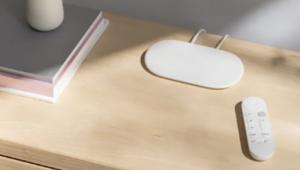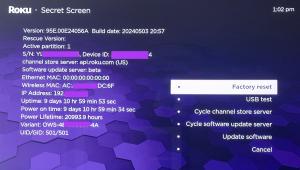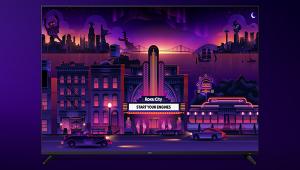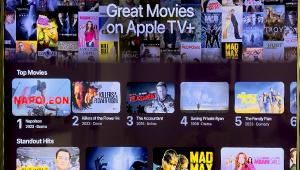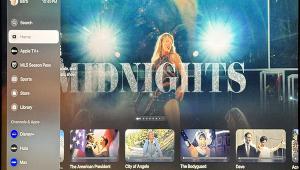Hands-On: Roku Streambar

The low-profile Streambar was the perfect size for my son's small bedroom. A full-size soundbar would have blocked the screen and been too long for the cabinet. Two of its four 1.9-inch drivers — each powered by a separate 8-watt amp — face forward and two are angled toward the side walls to create a virtual surround effect that widened the soundstage considerably.
Roku provides several sound adjustments, including a voice clarity mode that made dialogue more intelligible and a bass boost function that filled out the bottom end of a system that otherwise produces very little bass. The Night mode helped keep loud sounds in check, which was helpful since my son’s room shares a wall with my home theater.
There’s also an automatic audio leveling mode to tame loud commercials. Oddly, I found that it had the effect of increasing the volume of sound effects like footsteps and background voices. On the bright side, it created a welcome separation of sound during the final fight scene in The Avengers movie on Disney+.
The Streambar on its own delivers better sound than the speakers built into most TVs for the reasonable price of $130, but you can greatly improve the overall sound by using it as the front speaker in a full Roku surround-sound setup, which adds Roku’s wireless subwoofer ($180) and a pair of wireless speakers for placement in the back of the room ($200, discounted to $150 as of this writing). The sub provided a much-needed bass boost, while the additional speakers expanded the soundstage, allowing sound to move around the room.
Music also benefitted from the full Roku treatment. When streaming Pandora or Spotify to the Streambar alone, the sound was confined — like listening to a smart speaker. But when I engaged the full ensemble, music came alive with better separation and a much fuller sound.
Easy Set-Up
Compared with most audio systems, set-up is simple. You connect an HDMI cable from the Streambar to your TV's HDMI ARC (Audio Return Channel) port — just make sure HDMI-CEC (Consumer Electronics Control) and ARC are enabled on the TV. Roku provides an optical audio cable and offers helpful information and set-up guidance on its website.
Setup is even easier if you have a Roku TV. You can use the TV’s remote to control the Streambar, which connects automatically and gives you the option of renaming its input. And if you have a Roku account, all of the channels you’ve previously downloaded to other devices will automatically download to the Streambar.
In the case of full Roku surround setup, the Streambar discovers the subwoofer and rear speakers and automatically connects with them when you answer yes to a prompt. Roku says it’s planning to release an update in the coming months that would also include the ability to adjust the speaker levels.
Roku Streaming Player On Board
The Roku streaming player built into the Streambar can handle 4K/HDR10 content playback but it does not support DolbyVision. Picture quality is excellent and navigation is fast thanks to Roku’s new quad-core processor. Channels also open quickly at launch, which is nice.
Although the Streambar has updated to Roku OS 9.4, many of the anticipated features have yet to arrive, including AirPlay 2 and Siri Control.
Along with the Roku voice commands on the Voice remote, the Streambar supports Siri voice control, Alexa and Google Assistant (I was able to control the bar from my Google Home speaker). Voice commands can be used to search for content, control playback, launch apps, and more.
Final Thoughts
If you are looking for a step-up in TV sound quality or want to add surround sound in a room with limited space, the Roku Streambar is reasonably priced option at $130, or just over $500 for a complete surround-sound setup. While there are many other soundbar options to choose from, none come with a built-in 4K HDR streamer that is so easy to set up.
- Log in or register to post comments
